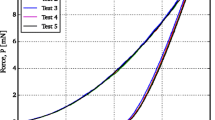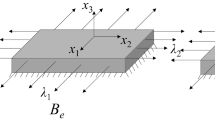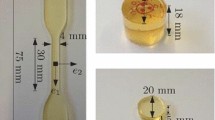Abstract
To evaluate mechanical properties by means of nanoindentation, information on the contact area is crucial. However, the contact area is not directly accessible in experiments and is usually calculated according to the Oliver and Pharr procedure, which turned out to be unsatisfying when applied to viscoelastic materials like polymers. In this study, complementary in situ indentation testing and finite element analysis (FEA) were performed on silicone elastomers. Through this combination of techniques, several individual error sources in the conventional contact area determination have been identified and quantified. For shallow penetrations, contact areas after Oliver and Pharr were up to 40% smaller than the in situ testing results; for larger penetrations, the contact size was overestimated by approximately 6%. The deviations of the resulting mechanical properties were approximately 10%. Viscoelastic effects could be captured if dynamic indentation testing was performed.
Similar content being viewed by others
References
J-L. Bucaille, E. Felder, and G. Hochstetter: Mechanical analysis of the scratch test on elastic and perfectly plastic materials with the three-dimensional finite element modeling. Wear 249, 422 (2001).
S. Shim, W.C. Oliver, and G.M. Pharr: A critical examination of the Berkovich vs. conical indentation based on 3D finite element calculations, in Fundamentals of Nanoindentation and Nanotribology III, edited by K.J. Wahl, N. Huber, A.B. Mann, D.F. Bahr, and Y-T. Cheng (Mater. Res. Soc. Symp. Proc. 841, Warrendale, PA, 2005), R9.5.1.
M. Li, W-M. Chen, N-G. Liang, and L-D. Wang: A numerical study of indentation using indenters of different geometry. J. Mater. Res. 19, 73 (2004).
N. Yu, A.A. Polycarpou, and T.F. Corny: Tip-radius effect in finite element modeling of sub-50nm-shallow nanoindentation. Thin Solid Films 450, 295 (2004).
Y. Sun, T. Bell, and S. Zheng: Finite element analysis of the critical ratio of coating thickness to indentation depth for coating property measurements by nanoindentation. Thin Solid Films 258, 198 (1995).
H.F. Wang and H. Bangert: Three-dimensional finite element simulation of Vickers indentation on coated systems. Mater. Sci. Eng., A 163, 42 (1993).
T.A. Laursen and J.C. Simo: A study of the mechanics of microt indentation using finite elements. J. Mater. Res. 7, 618 (1992).
A. Bolshakov, W.C. Oliver, and G.M. Pharr: Influences of the stress on the measurement of mechanical properties using nanoin dentation: Part II. Finite element simulations. J. Mater. Res. 11, 760 (1996).
M. Lichinchi, C. Lenardi, J. Hauptand, and R. Vitali: Simulation of Berkovich nanoindentation experiments on thin films using finite element method. Thin Solid Films 312, 240 (1998).
K-D. Bouzakis and N. Michailidis: Indenter surface area and hardness determination by means of a FEM-supported simulation of nanoindentation. Thin Solid Films 494, 155 (2006).
K. Li, T.W. Wu, and J.C.M. Li: Contact area evolution during an indentation process. J. Mater. Res. 12, 2064 (1997).
P-L. Larsson, A.E. Giannakopoulos, E. Söderlund, D.J. Rowcliffe, and R. Vestergaard: Analysis of Berkovich indentation. Int. J. Solids Struct. 33, 221 (1996).
S. Swaddiwudhipong, J. Hua, K.K. Tho, and Z.S. Liu: Equivalency of Berkovich and conical load-indentation curves. Modell. Simul. Mater. Sci. Eng. 14, 71 (2006).
S. Swaddiwudhipong, L.H. Poh, J. Hua, Z.S. Liu, and K.K. Tho: Modeling nano-indentation test of glassy polymers using finite elements with strain gradient plasticity. Mater. Sci. Eng., A 404, 179 (2005).
S. Gupta, F. Carillo, M. Balooch, L. Pruitt, and C. Puttlitz: Simulated soft tissue indentation: A finite element study. J. Mater. Res. 20, 1979 (2005).
S.D. Chen and F.J. Ke: MD simulation of the effect of the contact area and tip radius on nanoindentation. Sci. China, Ser. G 47, 101 (2004).
R. Komanduri, N. Chandrasekaran, and L.M. Raff: MD simulation of indentation and scratching of single crystal aluminum. Wear 240, 113 (2000).
A. Hasnaoui, P.M. Derlet, and H. Van Swygenhoven: Interaction between dislocations and grain boundaries under an indenter-A molecular dynamics simulation. Acta Mater. 52, 2251 (2004).
G. Päzold, A. Linke, T. Hapke, and D.W. Heermann: Computer simulation of nanoindentation into polymer films. Z. Phys. B: Condens. Matter 104, 521 (1997).
K. Yashiro, A. Furuta, and Y. Tomita: Nanoindentation on crystal/amorphous polyethylene: Molecular dynamics study. Commit. Mater. Sci. 38, 136 (2006).
W.C. Oliver and G.M. Pharr: An improved technique for determining hardness and elastic modulus using load and displacement sensing indentation experiments. J. Mater. Res. 7, 1564 (1992).
I.A. Sneddon: The relation between load and penetration in the axissymmetric Boussinesq problem for a punch of arbitrary profile. Int. J. Eng. Sci. 3, 47 (1965).
L. Anand and N.M. Ames: On modeling the micro-indentation response of an amorphous polymer. Int. J. Plast. 22, 1123 (2006).
P-L. Larsson and S. Carlsson: On microindentation of viscoelastic polymers. Polym. Test. 17, 49 (1998).
Y-T. Cheng and C-M. Cheng: Relationship between initial unloading slope, contact depth, and mechanical properties for conical indentation in linear viscoelastic solids. J. Mater. Res. 20, 1046 (2005).
A.E. Giannakopoulos and A. Triantafyllou: Spherical indentation of incompressible rubber-like materials. J. Mech. Phys. Solids 55, 1196 (2007).
S.J. Jerrams, M. Kaya, and K.F. Soon: The effects of strain rate and hardness on the material constants of nitrile rubbers. Mater. Des. 19, 157 (1998).
W. Kuhn: On the shape of fibrous molecules in solutions. Kolloid-Zeitschrift. 68, 2 (1934).
E. Guth and H. Mark: Rubber elasticity and its relationship to the structural model. Naturwissenschaften 25, 353 (1937).
L.R.G. Treloar: The elasticity of a network of longchain molecules I. Trans. Faraday Soc. 39, 36 (1943).
L.R.G. Treloar: The elasticity of a network of longchain molecules II. Trans. Faraday Soc. 39, 241 (1943).
ABAQUS Theory manual (ABAQUS Inc., Providence, RI, 2006).
M. Mooney: A theory of large elastic deformation. J. Appl. Phys. 11. 582 (1940).
R.S. Rivlin: Large elastic deformations of isotropic materials IV: Further developments of the general theory. Philos. Trans. A 241, 379 (1948).
R.W. Ogden: Large deformation isotropic elasticity-On the correlation of theory and experiment for incompressible rubberlike solids. Proc. R. Soc. London, Sect. A 326, 565 (1972).
O.H. Yeoh: Characterization of elastic properties of carbon-black-filler rubber vulcanizates. Rubber Chem. Technol. 63, 792 (1990).
E.M. Arruda and M.C. Boyce: A three-dimensional constitutive model for the large stretch behavior of rubberelastic materials. J. Mech. Phys. Solids 41, 389 (1993).
L. Valenta and L. Molnar: Comparison of the Neo-Hooke model and the Mooney-Rivlin model in FEA. Periodica Polytechnica Mech. Eng. 45, 95 (2001).
P. Raos: Modelling of elastic behaviour of rubber and its application in FEA. Plast. Rubber and Compo. Process. Appl. 19, 293 (1993).
J. Deuschle, E.J. de Souza, S. Enders, and E. Arzt: Crosslinking and curing kinetics of PDMS studied by dynamic nanoindentation, to be published.
B.N. Lucas, W.C. Oliver, G.M. Pharr, and J-L. Loubet: Time dependent deformation during indentation testing, in Thin Films: Stresses and Mechanical Properties VI, edited by W.W. Gerberich, H. Gao, J-E. Sundgren, and S.P. Baker (Mater. Res. Soc. Symp Proc. 436, Pittsburgh, PA, 1997), p. 233.
ABAQUS Analysis User’s Manual (ABAQUS Inc., Providence, RI, 2006).
Z. Hicsasmaz and S.S.H. Rizvi: Effect of size and shape on modulus of deformability. LWT 38, 431 (2005).
R. Brown: Physical Testing of Rubber, 4th ed. (Springer, New York, 2006), p. 151.
N. Chollacoop and U. Ramamurty: Experimental assessment of the representative strains in instrumented sharp indentation. Scr. Mater. 53, 247 (2005).
L.R.G. Treloar: The Physics of Rubber Elasticity, 3rd ed. (Clarendon Press, Oxford, 1975).
Y. Choi, H-S. Lee, and D. Kwon: Analysis of sharp-tip indentation curve for contact area determination taking into account pile-up and sink-in effects. J. Mater. Res. 19, 3307 (2004).
J. Deuschle, S. Enders, and E. Arzt: Surface detection in nanoindentation of soft polymers. J. Mater. Res. 22, 3107 (2007).
K.L. Johnson, K. Kendall, and A.D. Roberts: Surface energy and the contact of elastic solids. Proc. R. Soc. London, Sect. A 324, 301 (1971).
Author information
Authors and Affiliations
Corresponding author
Rights and permissions
About this article
Cite this article
Deuschle, J.K., Deuschle, H.M., Enders, S. et al. Contact area determination in indentation testing of elastomers. Journal of Materials Research 24, 736–748 (2009). https://doi.org/10.1557/jmr.2009.0093
Received:
Accepted:
Published:
Issue Date:
DOI: https://doi.org/10.1557/jmr.2009.0093




